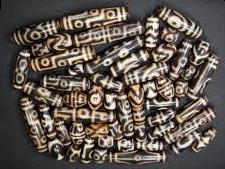Dzi bead is a bead stone of mysterious origin worn as part of a necklace and sometimes as a bracelet. In several Asian cultures, including that of Tibet, the bead is considered to provide positive spiritual benefit. These beads are generally prized as protective amulets and are sometimes ground up into a powder to be used in traditional Tibetan medicine. Beads subject to this process have small "dig marks" where a portion of the bead has been scraped or shaved away to be ground into the medicine.
Beads that are broken are believed to have a diluted benefit, because they have taken the brunt of the force that it is assumed would have otherwise impacted the wearer.
The most highly prized dzi beads are made of natural agate and were apparently manufactured in ancient times by an unknown people. There are also new dzi which gain popularity amongst Tibetans.
Dzi stones are made from agate, and may have decorated symbols composed of circles, ovals, square, waves (zig zags), stripes, lines, diamonds, dots, squares, waves, and stripes and various other natural archetypal symbolic patterns. Colors will mainly range from browns to blacks with the pattern usually being in ivory white. Dzi beads can appear in different colours, shapes and sizes.
The number of "eyes" on the stone is considered significant. "Eyes" are the circular dot or eye-like designs, and depending on their number and arrangement, they represent different things.
Sometimes the natural patterns (usually "layered" swirls) of the agate can be seen underneath or behind the decorated symbols and designs, and sometimes not.
Some dzi beads sport what are referred to as "blood spots" which can be seen as tiny red dots in the white areas, and these are indicative of cinnabar content. This is highly desirable, but more rare. Another desirable effect is something called "Nāga skin" which refers to tiny circular weathering marks on the surface of the bead, that simulates scales.
The word "waxy" is often used to describe dzi bead surface, which is the smoothing which occurs over a long period of time (presumably from wear), giving the bead a waxy appearance. Some dzi beads are simply polished agate and sport only the agate's natural patterning as decoration.
The highest number of eyes on ancient dzi is twelve. One thirteen-eye bead has been reported from a Taiwan collector but its genuineness has been unconfirmed; therefore anything having more than twelve eyes can be considered non-traditional. Any accompanying story or benefit tale can be assumed to be fake as well, and a mere marketing strategy on the lucrative Feng Shui item market.


